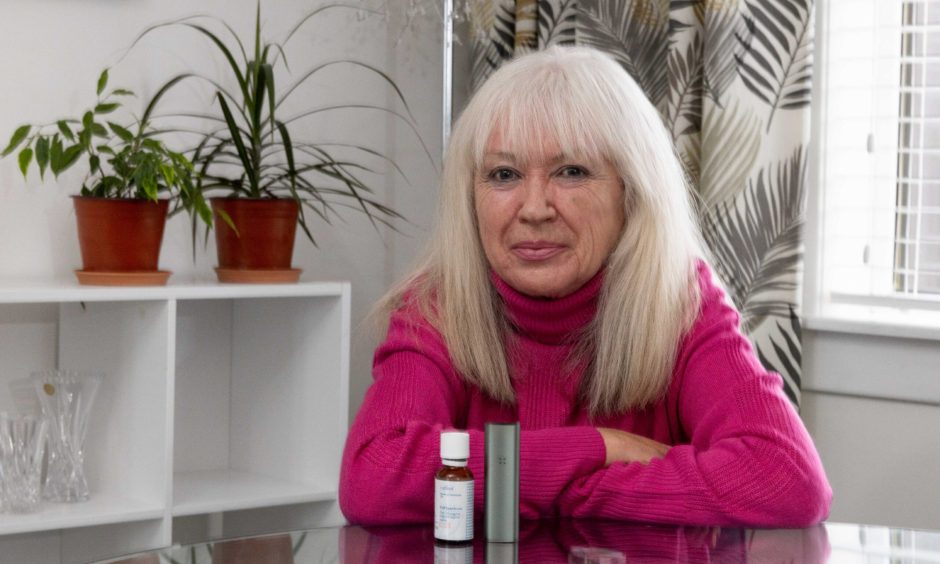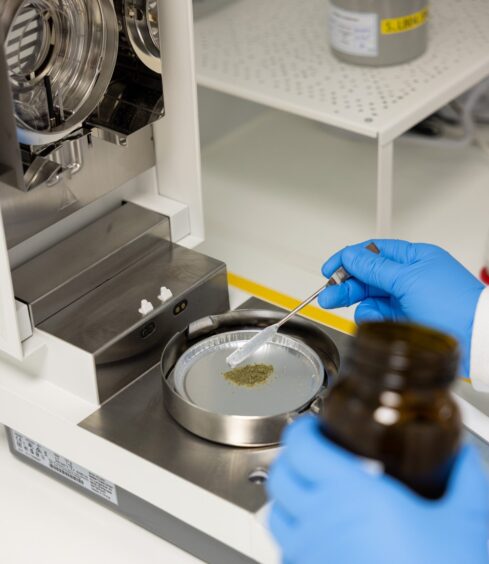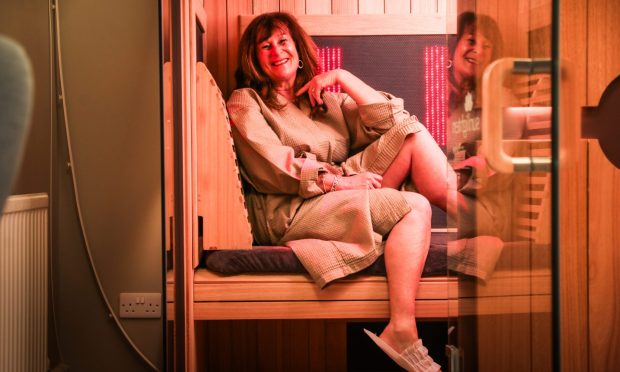“Cannabis absolutely saved my life.”
When Montrose woman Alison Wilson says this to me, there’s no hint of exaggeration.
The retired hospice nursing assistant is one of the estimated 35,000 patients who have been prescribed medical cannabis since it was legalised in November 2018.
Since then, it has been used to treat neurological conditions (such as epilepsy and MS), mental health conditions (including PTSD, autism spectrum disorder and ADHD) and chronic pain conditions like arthritis, endometriosis, fibromyalgia and more.
And Alison is among the estimated 50% of patients who use medical cannabis to treat chronic pain. Hers stems from severe osteoporosis.
“There’s a pie-shaped piece missing from one of my vertebrae,” explains Alison, 68. “I’m in pain constantly, 24/7 and have been for five or six years now.
“During the day, it’s more manageable because you have distractions,” she says. “But my biggest problem was I couldn’t sleep at night.”
Alison tried a Goldilocks regime of traditional painkillers, but found that all of them came with adverse side effects.
“One of them didn’t work at all, it didn’t help me sleep,” she says. “The second did, but gave me an awful hangover feeling which meant I lost the next day.
“And the third made me so nauseous, I was vomiting all the time. I was at the end of my tether, really.”
Easier access to medical cannabis in US?
Before her move to Angus in 2022, Alison was living in Florida in the United States, where she used medical cannabis to manage her pain.
But when she moved to the UK, she didn’t even try to continue her medical cannabis treatment.
“Over there, they have cannabis pharmacies that you can walk into and, if you have a prescription, choose what you want,” she explains.
“The impression I got here was that the medical cannabis qualification was so narrow, you had to be almost dying to get it,” she admits.
But after a couple of friends recommended private UK cannabis clinic Curaleaf (previously Sapphire) to Alison, she found that she did qualify for the medication – because front-line treatments had failed to work for her.
Now she spends upwards of £200 a month for a combined treatment of liquid cannabis oil at night and flower (taken in a vaporiser) during the day to manage her pain.
“It’s absolutely life-changing,” she smiles. “I go to sleep like a normal person, I wake up and don’t feel ill. It really has absolutely saved my life.”
Gino, 9, uses cannabis to treat seizures
Meanwhile over in Kirkcaldy, schoolboy Gino Londra, 9, has been being prescribed medical cannabis since 2021.
He suffers from rare genetic disorders 1p36 deletion syndrome and West Syndrome, which cause severe epilepsy.
Before using medical cannabis, Gino would have around 600-800 seizures every month.
According to Gino’s mother Charlene, the NHS “literally told us there was nothing else they could do”.
At the time, they were denied an NHS medical cannabis prescription, which prompted the family to seek out private treatment.
And Charlene says medical cannabis has reduced Gino’s number of seizures by around 80% meaning that for the first time, he was able to have real “quality of life”.
“When he was on the privately prescribed medical cannabis, he spent more time at school than ever before. He was having fewer episodes and that meant less time in hospital,” she explains.
The downside? Cost.
“We’re about £600 for five weeks of medication,” says Charlene. “My son’s got complex needs, he needs 24/7 care, so my husband’s a stay-at-home dad. It’s not doable without fundraising.”
For the first three years of his treatment, Gino’s family raised £37,000 through raffles, race nights and bake sales to give the nine-year-old “a modicum of comfort” as he navigates life with an incurable condition.
NHS approved medicine ‘doesn’t work’
Recently, Gino was finally able to get medical cannabis prescribed on the NHS.
And while this took the financial strain off the Londras for a short time, there’s a big snag.
“It doesn’t work,” sighs Charlene. She explains that the NHS only offers products which contain CBD or synthetic cannabis, not the THC bioactive compound which she believes was helping Gino.
“His seizures are going up again. He was up at 26 in one day just the other day. We were at 80 a month before, so we’re looking at going private again.”
What’s the hold up with medical cannabis in the UK?
Both of these cases raise a number of questions:
- Why, six years after medical cannabis was legalised in the UK, is it so hard to get?
- Why are patients with prescriptions still having to pay extortionate monthly sums to private clinics in order to receive potentially life-changing treatment?
- And what can be done about it?
The short answer to the first two, according to Curaleaf Clinic research director Simon Erridge, is that cannabis is a plant. And a plant, unlike a pill, is hard to standardise.
“Cannabis is a really difficult plant to study, in terms of its medical effects,” says Simon, a medical doctor and researcher who was involved in setting up the UK’s first regulated medical cannabis clinic and data registry.
“Most medicines come in a very formulaic, one-substance format in specific doses.
“Medical cannabis can contain isolated compounds such as CBD or THC. But it can also contain a real broad spectrum of other minor compounds.
“And it can be prescribed in a number of different formats: dried flower, pastilles, oil.”
‘Unlicensed’ status is one of several barriers
Simon explains that the diversity of medical cannabis makes it difficult to scale up to traditional clinical research trials.
And without the large-scale trials, Simon says medical cannabis can’t be determined to be a cost-effective treatment for the NHS.
This, he explains, is the biggest barrier to medical cannabis entering mainstream healthcare pathways.
Could Dundee scientists unlock the future of medical cannabis treatment?
But there is light at the end of this tunnel – with scientists in Dundee leading the way.
Researchers at the city’s James Hutton Institute in Invergowrie have this year secured £350k in funding for pioneering medical cannabis research.
Professor Derek Stewart, director of the Advanced Plant Growth Centre at the institute, explains how their work could help bridge that gap between the “variable” nature of a plant and the standardisation needed for clinical studies.
“The standard cannabis plant looks kind of like a Christmas tree,” explains Derek, who attended Kirkton High School in the city before going on to study chemistry at Dundee University.
“And the problem with that is that generally you’re growing these plants inside. So you’re giving them light from the top.
“What that means is the combination of active components is different in the top flowers than the bottom ones, because they’re seeing less light.
“So we want to see if we can change the structure of the plant, the architecture, so it looks more like a candelabra.”
Growing plants is ‘like blending whiskies’
Derek hopes that if the plant can be grown in different structures, it can also be bred to give a “more stable chemical make up”.
This would reduce the variability in treatment.
Then scientists could zero in on particular compounds through certain strains of the plant. And then they could cross-breed them to optimise for different treatments.
“It’s along the lines of blending whiskies to achieve different flavours,” he says.
“Potentially, you could then grow cannabis plants with all different bioactives in them. And then start blending them to make very accurate medicines going out.
“Then rather than just giving a generic one to everyone, everyone gets the best treatment they can. We’d have the perfect blend.”
In Montrose, Alison is delighted by the news of the research funding, saying: “I think it’s fabulous they’re looking into it.”
But for youngster Gino’s mum Charlene, the news of better products coming down the line is bittersweet.
“It’s good that things are moving,” she says. “It’s just far too slow for my child.”
Medical cannabis is entirely separate from illicit cannabis. Illicit cannabis carries risks of harmful substances, including mould. Medical cannabis is grown in medical-grade conditions.



















Conversation